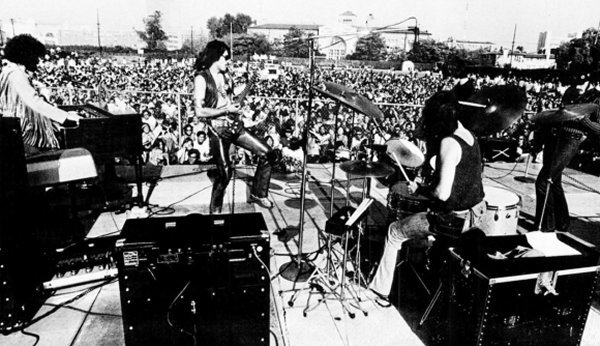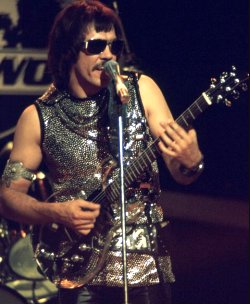

The year was 1975 and it was a hot day in August at the racetrack in the Black Hills. Styx had just left the stage and I anxiously waited
in the fifth row for Steppenwolf to come up next. While this photo is not from that concert, it gives a fair approximation of it.

|

|
When they did I was in for more of a treat than I bargained for. A few feet in front of me, and a bit to my right stood
John Kay. As his welcomed "Hello" echoed through the grandstands I stood mesmerized for I noticed he had slung
on a Dan Armstrong guitar. However, it didn't take me very long to realize that this was no regular Dan Armstrong that he
was playing, for it had been heavily modified. It was obvious to me that it was an expensive, high quality modification.
Little could I have known that some 40 years later I would see that guitar again, this time up close, thanks to Mr. Nathan
Fasold, owner of Black Book Guitars. who acquired
this rare bird. As seen at left, the acrylic body has had its faux-wood scratchplate replaced by a chrome plated metal one, which
was topped off with a Gibson humbucking pickup with a chrome plated cover. The combination bridge/tailpiece assembly
has been replaced with chrome plated parts as well, consisting of an unknown tailpiece (ideas... anyone?) which is positioned just behind a Gibson
'Harmonica' type tunomatic bridge. At right, and seen from the back, notice the extra routing in the body for the bridge
and tailpiece, as well as a neck finished in black. Notice too, the lack up a pickup thumbscrew to secure the pickup in place.
At left, and seen better in enlarged view, notice two switches in addition to the one normally seen on these guitars. When
asked about them, Nathan first spoke of the most forward switch (with the black button) - stating "It appears that button is
a momentary kill switch, the next switch back is a total kill switch. The last switch, by the output jack - is a split coil switch."
At right, and resting up against a Marshall cabinet, reflections of a hand can be seen in the chrome plated scratchplate.
At left, the black finished neck sports large half-circled position markers that take up the full length of the fret that they represent. In
this photo these position markers appear to be white. Set against a black finished neck, they definitely stand out. However, as seen at right,
and better seen in enlarged view, these markers show that they are actually mother of pearl. In many interviews John Kay has mentioned his vision
loss, especially on stage where lighting (or the lack thereof....at times) can be challenging for him. As one who also does alot of slide work,
he would not be the first one to access a Dan Armstrong guitar and with large position markers, coupled with a neck of such contrast, it would be
the perfect fit for John.
Also notice some dents on the backside of the neck. Nathan Fasold states "There are dents high up on the back of the neck
which I initially thought were from resting the guitar up against amps and such. After watching videos of John Kay playing slide on this guitar I learned
the marks were from a capo. An example is Steppenwolf performing Born to Be Wild on the Midnight Special show in late 1974. John plays with a capo crimped
on the first fret of his modified Dan Armstrong guitar."
At left, and keeping in the Dan Armstrong fashion, the original faux-wood veneer on the headstock has been replaced with a chrome plated
metal veneer that matches the scratchplate. Seen better in the enlarged view, one thing I would have done (minor as it is) - would be to have
countersank the holes for the screws that secure the truss rod cover in place, so that they would sit more flush with the cover.
At right, and also seen better in enlarged view, it appears that the tuner for the 6th string has been replaced with one that is
virtually identical, with the only exception of its nickel plating. Notice too, a bit of an ano moly - seen on the tuner for the
1st string which is sporting a newer type larger washer.
At left, an incredible view of the housing for the humbucking pickup. According to Nathan Fasold, "The pickup surrounding is mostly wood.
Someone did a great job making it!" Better seen in the enlarged view, notice how the metal (aluminum??) bottom portion of the pickup surrounding
has a nut welded on to accept the usual 6-32 pickup screw, though given the modifications to this guitar it could be larger in size. Notice too, the
six screws on the bottom that apparently secure the wooden trim portion to this metal bottom plate.
Lastly, notice the banana plugs, and in particular the insulating (rubber???) material surrounding the female portion of these plugs. Notice too an
open hole next to those plugs - no doubt once used for the third male banana plug mounted alongside the others in the slide-in pickup channel.
Apparently, this part of the wiring modification was no longer used, nor desired. With the pickup removed, you can see the black finish of the necks tongue.
At left, and according to Nathan, a portion of the wiring scheme no longer has been identified, stating "The split coil jack has been disconnected
at pickup, so the split coil switch does not do much." Seen here, the white wire has been disconnected from the right side banana plug in this photo.
At right, and seen better in the enlarged view, notice how different the momentary kill switch looks compared to the other two.
At left, Nathan continues, stating "The tone and volume pots are 250k, dated late 1964 (304-6450)- maybe a surplus of pots were purchased."
Surplus indeed, for Dan Armstrong hadn't even opened up his shop until 1965, and the earliest Dan Armstrong · Ampeg instruments
are dated 1969.
At right, a number of years would pass before this instrument would be produced. As seen here, a serial number of A2129D places this instrument as a
later 1970s model. It seems very ironic to me that a neck which was finished black would just happen to have its serial number stamped
onto the top of the tongue when the number is away's seen on the side of the tongue on these necks. Even the necks employed by the black prototype
models were stamped into the side of the tongue. True - some (though not all) also had the serial number written onto the top of the tongue using
a pencil, as can be seen in the Guitar section of this site, and that's totally understandable being those bodies are black.
But John's guitar is clear, and there really was no reason at all to stamp the serial number into the top of the necks tongue at the factory - and
I really don't think it was. The clue, to me anyway, lies in the serial number itself. Not the actual number per-se - that seems legit - but notice
how neat and straight-in-line, as well as the number spacing of the serial number is. Now check your Dan Armstrong instrument (or go online to have
a look). While there are always exceptions, this level of neatness is..... to me anyway, something rather out of character for Ampeg. Rather, I feel
that those who worked on this instrument most likely stamped the serial number into the top. The number is still on the side of the neck mind you,
but likely out of sight being the entire neck was finished in black.
The only question I have is why bother? Was this done at John's request? It would seem likely, as doing such a thing without permission from the
owner seems going too far. I believe there had to have been at least a tacit of approval from John.
At left, Nathan Fasold, owner of Black Book Guitars, as well as this rare, one-of-a-kind Dan Armstrong · Ampeg guitar
can be seen in his shop, while at right, and with all the modifications to this instrument, it still weighs in at 9 pounds, 15.4 ounces - not
that far off from a stock model.
continue
menu
Names and images are TMand © Dan Armstrong / Ampeg. All rights reserved.
All other names and images are TMand © of their respective owners. All rights reserved.
|
| |

